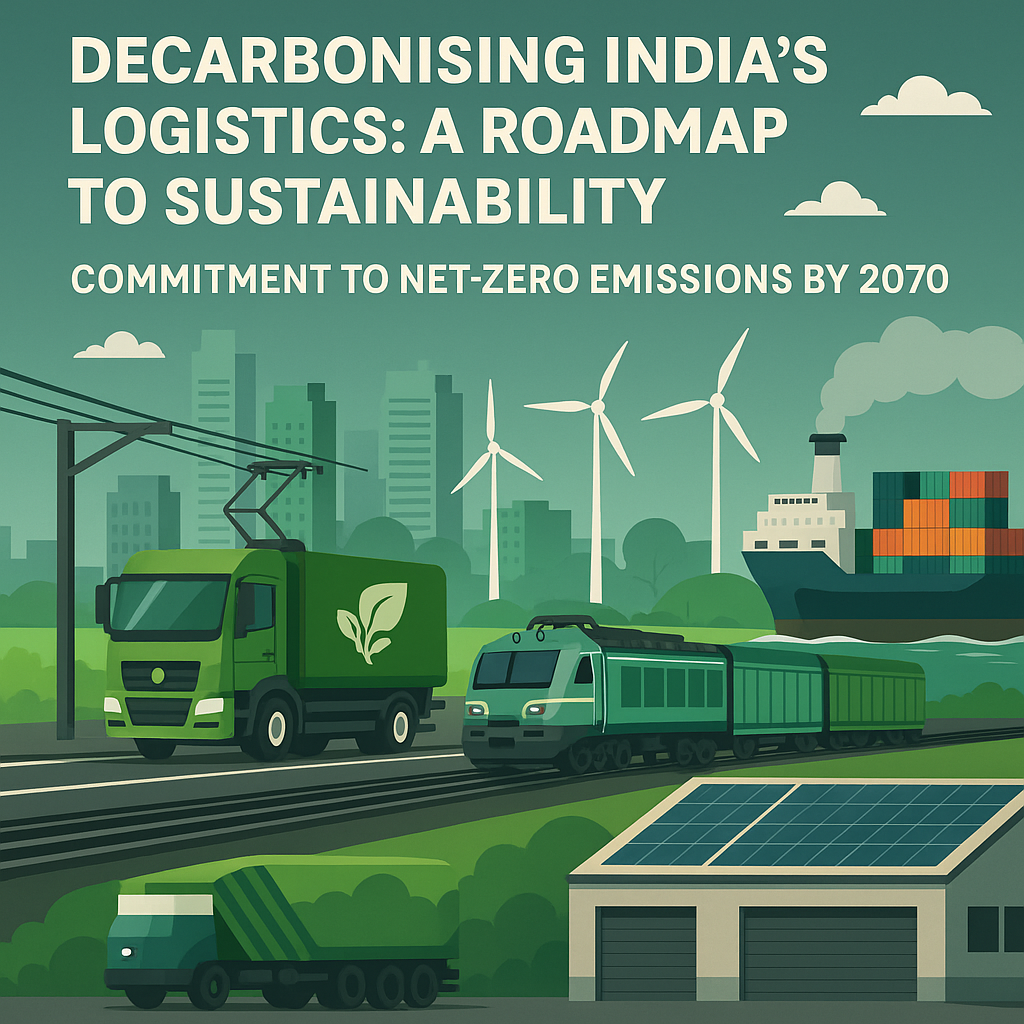Decarbonising India’s Logistics: A Roadmap to Sustainability
Syllabus:
GS-2:
Government Policies & Interventions , Issues Relating to Development
GS-3:
Environmental , Pollution & Degradation , Industrial Policy , Industrial Growth , Infrastructure
Focus:
India’s logistics sector is one of the largest contributors to greenhouse gas emissions, primarily from road transport and warehousing. With the country’s commitment to achieving net-zero emissions by 2070, the need to decarbonise logistics has become critical. Government initiatives, innovative solutions, and a shift to greener modes of transport are essential for transforming India’s logistics ecosystem.
Logistics as the Backbone of Viksit Bharat :
- Viksit Bharat 2047 Vision:
- India’s ambition to become a developed, self-reliant, and inclusive economy by 2047.
- Inclusive development means ensuring growth touches every individual, business, and region.
- Logistics Sector: The Growth Engine
- An efficient logistics system is the foundation of sustained economic growth.
- From supply chain efficiency to last-mile connectivity, logistics drives equitable progress.
- To meet developmental goals, logistics must be large-scale, efficient, and environmentally sustainable.
- Environmental Imperative:
- Growth cannot be sustainable without factoring in ecological well-being.
- India’s logistics system must evolve into a future-ready, green network.
- Reducing transportation, warehousing, and supply chain emissions is critical to India’s net-zero target by 2070.
Current Scenario: The Carbon Cost of Indian Logistics
- High Emission Contribution:
- The logistics sector is one of India’s largest contributors to carbon emissions.
- It accounts for 5% of India’s total greenhouse gas emissions.
- Road Transport: The Major Polluter:
- Roads handle 90% of passenger traffic and 70% of freight.
- Trucks alone contribute 38% of total CO2 emissions.
- Overdependence on oil combustion makes road freight the largest carbon emitter.
- Other Modes and Their Footprint:
- Domestic aviation: ~4% of total emissions — hard to decarbonise.
- Coastal shipping and inland waterways: Emit less than roads but are poised for growth.
- Planned expansion by 2030:
- Inland water cargo to triple.
- Coastal cargo to grow by 2 times.
- Warehousing Sector’s Hidden Impact:
- Often overlooked, warehousing is a major energy consumer.
- Emissions arise from electricity and fossil-fuel reliance for temperature control and lighting.
- Challenge of Balancing Growth and Sustainability:
- Economic expansion and environmental preservation must go hand-in-hand.
- Without decarbonisation, growth will be environmentally unsustainable.
Global and Indian Approaches to Decarbonising Logistics:
A. Rail Freight: The Low-Carbon Champion
- Global Success Stories:
- China: Rail handles nearly 50% of freight — major emission savings.
- United States: Strong rail freight reduces carbon footprint compared to roads.
- Indian Potential:
- Railways already a pioneer in electrification.
- Scaling up rail’s share in freight transport will improve efficiency and reduce emissions.
B. Road Freight: Greener Pathways for Trucks
- Structural Reforms Needed:
- Current road freight heavily oil-dependent.
- Introduction of electric trucks and green highways needed for decarbonisation.
- Innovative Indian Pilot:
- Delhi-Jaipur E-Highway Project:
- Overhead electric wires for trucks.
- First step towards creating electric highways for freight transport.
- Promises higher efficiency and lower emissions.
- Delhi-Jaipur E-Highway Project:
C. Coastal Shipping and Inland Waterways
- Emission Reduction Potential:
- Lower emissions per tonne-km compared to road transport.
- International Maritime Organization (IMO) targets 50% cut in shipping emissions by 2050.
- Future Strategies for India:
- LNG-powered vessels.
- Solar-assisted electric boats.
- Electric and biofuel-run barges for inland cargo.
- Lower carbon footprint while maintaining efficiency.
D. Air Transport: Decarbonisation Challenges
- Aviation’s Dependency on Refined Fuels:
- Difficult to decarbonise due to technical limitations.
- Sustainable aviation fuels (SAFs) and technological upgrades offer long-term hope.
E. Warehousing: The Silent Carbon Contributor
- Energy-Intensive Operations:
- Lighting, cooling, and heating rely on non-renewable energy.
- Solutions include:
- Solar rooftop systems.
- Wind and geothermal energy integration.
- Smart energy management to reduce power wastage.
Why Decarbonisation is Essential for India’s Logistics Sector:
- Beyond Emission Reduction:
- Not just about cutting CO2; it’s about:
- Competitiveness: Lower operational costs through energy efficiency.
- Resilience: Reduced vulnerability to fuel price fluctuations.
- Future-Readiness: Compliance with global environmental standards.
- India’s Decarbonisation Roadmap:
- Scale up rail freight to reduce road dependence.
- Electrify highways and shift to electric trucking.
- Promote green fuels and clean maritime solutions.
- Invest in solar-powered and energy-efficient warehouses.
- Policy and Investment Imperatives:
- Support from both public and private sectors is needed.
- Incentives for adopting clean technologies.
- Strong regulatory framework for emission tracking.
- Not just about cutting CO2; it’s about:
Way Forward: Accelerating the Green Transformation
- Building a Sustainable Ecosystem:
- Decarbonisation is no longer a choice but a necessity.
- A green logistics network ensures balanced development without environmental degradation.
- Policy Push and Private Sector Role:
- Need for:
- Policy certainty.
- Technology partnerships.
- Green infrastructure investments.
- Key Recommendations:
- Diversify freight away from roads to rail and waterways.
- Implement electrified truck corridors.
- Promote clean fuels in the maritime sector.
- Shift warehouses to renewable energy sources.
- Conclusion:
- The pathway for a greener logistics sector is clear.
- What’s needed is decisive action, strong political will, and steady investment.
- If India embraces this shift now, it can emerge as a global leader in sustainable logistics.
- Need for:
Conclusion:
India’s logistics sector is at a critical juncture. Decarbonising this sector will not only help meet the nation’s emission reduction targets but also create a more efficient, resilient, and future-ready economy. With bold initiatives like electrified highways, cleaner fuels, and a focus on renewable energy, India can lead the way in sustainable logistics. Swift and strategic action is needed to achieve a cleaner, greener logistics network.
Source: TH
Mains Practice Question:
“India’s logistics sector is among the most carbon-intensive in the world. Discuss the challenges and solutions to decarbonise the sector. How can the adoption of rail, electric trucks, and clean maritime fuel contribute to a sustainable future?” (150 words)




